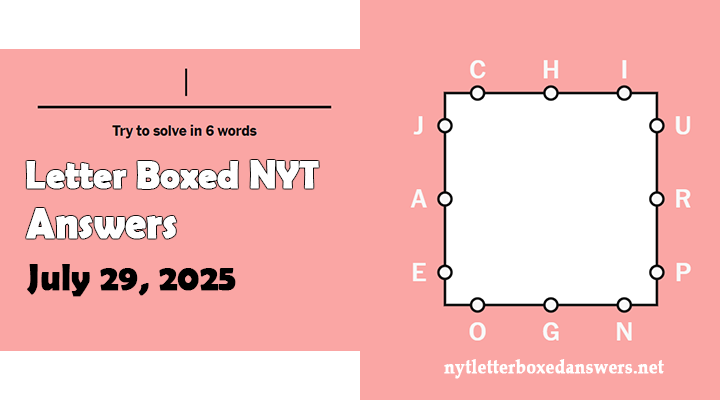NYT Letter Boxed quiz for Tuesday July 29, 2025 is released. We came up with Letter Boxed July 29 2025 Answers and Hints for you. With the help of these hints, you will be able to guess the words of letter boxed quiz without revealing the answers and get the solution.
| Top | Right | Bottom | Left |
|---|---|---|---|
| CHI | URP | OGN | JAE |
| Two Words Solution | ||
|---|---|---|
| JOUNCE | EPIGRAPH | |
| JOUNCE | EPIGRAPHER | |
| ARJUN | NECROPHAGI | |
| INJUN | NECROPHAGI | |
| Three Words Solution | ||
|---|---|---|
| CAPER | ROUGHAGE | EJOINER |
| APACE | EJOINER | ROUGHER |

Word 01:
6-letter word, starts with J, ends with E; to move with jolts.
A bumpy, jerky motion, especially in a vehicle.
Often felt when driving over rough terrain.
Similar in meaning to “bounce” or “jolt.”
Describes a sudden upward or downward movement.
May refer to physical shaking from impact.
Used in describing uncomfortable rides.
Can be a verb or a noun.
Found in old-style writing or poetic contexts.
Associated with mechanical shocks or tremors.
Word 02:
8-letter word, starts with E, ends with H; a short quotation at the start of a book.
Often used to set the tone or theme in literature.
Can be a quote, phrase, or poem.
Appears before the main text in novels or essays.
Not to be confused with epitaph.
Can come from famous literary or historical sources.
Often reflective, philosophical, or poetic.
Authors use it to hint at the story’s meaning.
Frequently italicized or offset in formatting.
Related to literary or academic writing.
Word 01:
6-letter word, starts with J, ends with E; to move with jolts.
A bumpy, jerky motion, especially in a vehicle.
Often felt when driving over rough terrain.
Similar in meaning to “bounce” or “jolt.”
Describes a sudden upward or downward movement.
May refer to physical shaking from impact.
Used in describing uncomfortable rides.
Can be a verb or a noun.
Found in old-style writing or poetic contexts.
Associated with mechanical shocks or tremors.
Word 02:
10-letter word, starts with E, ends with R; one who studies inscriptions.
A specialist in ancient or historical writings.
Works with stone, metal, or artifact inscriptions.
Involved in deciphering old languages or symbols.
May work in archaeology or museum research.
Related to fields like paleography and philology.
Reads carved or engraved texts.
Helps decode historical records.
From Greek roots meaning “upon writing.”
Not to be confused with calligrapher.
Word 01:
5-letter word, starts with A, ends with N; central figure in the Mahabharata.
A heroic archer in Hindu mythology.
Disciple of Lord Krishna.
Known for his role in the Kurukshetra war.
Symbol of bravery, focus, and devotion.
One of the five Pandava brothers.
Recipient of the Bhagavad Gita.
Also a popular boy’s name in South Asia.
Revered for discipline and righteousness.
Frequently depicted in Indian epics and scriptures.
Word 02:
11-letter word, starts with N, ends with A; consumption of dead flesh.
Often describes feeding behavior of carrion animals.
From Greek roots meaning “dead eating.”
Term used in biology and horror genres.
Can refer to certain insect or animal diets.
Name of a death metal band.
Associated with decomposition and scavenging.
Found in ecological and forensic contexts.
Also used metaphorically in dark literature.
Not to be confused with necrophilia.
Word 01:
5-letter word, starts with I, ends with N; outdated slang for Native American.
Now considered offensive and inappropriate.
Used in 19th-century Western literature.
Appears in novels like Huckleberry Finn.
Reflects a mispronunciation of “Indian.”
Frequently found in old cowboy movies.
No longer acceptable in modern usage.
Sometimes referenced in linguistic studies.
A cultural artifact of past stereotypes.
Included for historical awareness, not endorsement.
Word 02:
11-letter word, starts with N, ends with A; consumption of dead flesh.
Often describes feeding behavior of carrion animals.
From Greek roots meaning “dead eating.”
Term used in biology and horror genres.
Can refer to certain insect or animal diets.
Name of a death metal band.
Associated with decomposition and scavenging.
Found in ecological and forensic contexts.
Also used metaphorically in dark literature.
Not to be confused with necrophilia.
Word 01:
5-letter word, starts with C, ends with R; a playful skip or leap.
A mischievous or adventurous act.
Often refers to a fun or silly stunt.
Can also mean a small pickled flower bud used in cooking.
Associated with heists in comedy films.
A light-hearted prank or escapade.
Wordplay involving crime or jest.
Appears in “caper films” like Ocean’s Eleven.
Common term in old-time detective fiction.
A combination of fun, risk, and agility.
Word 02:
8-letter word, starts with R, ends with E; dietary fiber.
Promotes healthy digestion.
Found in vegetables, grains, and fruits.
Indigestible part of plant food.
Essential for regular bowel movements.
Also known as fiber in nutrition.
Recommended by doctors for gut health.
Increases stool bulk and softness.
Helps reduce cholesterol and blood sugar.
Think bran, cabbage, and celery.
Word 03:
7-letter word, starts with E, ends with R; one who unites or brings things together.
Not a common dictionary word—likely a coined or technical term.
Possibly refers to a tool or agent that connects parts.
Can be interpreted as someone who joins electronically.
May describe a component in a digital system or app.
Similar in structure to “joiner,” with added prefix.
Suggests action of linking or merging elements.
Could imply a joining function in tech or coding.
Used in constructed or puzzle word contexts.
Hypothetical role in collaborative platforms.
Word 01:
5-letter word, starts with A, ends with E; at a swift pace.
Means quickly or speedily.
Archaic or formal in modern usage.
Often used in historical or poetic texts.
“The project progressed apace” = moved quickly.
Appears in Shakespearean English.
Synonym: briskly or rapidly.
Still occasionally seen in legal writing.
Suggests steady forward movement.
Not related to “peace” despite sound.
Word 02:
7-letter word, starts with E, ends with R; one who unites or brings things together.
Not a common dictionary word—likely a coined or technical term.
Possibly refers to a tool or agent that connects parts.
Can be interpreted as someone who joins electronically.
May describe a component in a digital system or app.
Similar in structure to “joiner,” with added prefix.
Suggests action of linking or merging elements.
Could imply a joining function in tech or coding.
Used in constructed or puzzle word contexts.
Hypothetical role in collaborative platforms.
Word 03:
7-letter word, starts with R, ends with R; more coarse or harsh.
Comparative form of “rough.”
Describes texture, behavior, or conditions.
May refer to unpolished surfaces.
Used in weather forecasts or sailing.
Can describe aggressive play in sports.
Opposite of “smoother.”
Often used to compare terrains or voices.
Found in physical descriptions.
Common in descriptive storytelling.

Chris Brown is a passionate word game love and problem solving expert. With over 15 years of experience in solving puzzle challenges, he provides daily NYT Letter Boxed answers, tips and strategies to help other players so that they can improve their solving skills. Whether you are stuck on a tricky puzzle or looking for new techniques, Chris is here to guide you with his expert solutions.